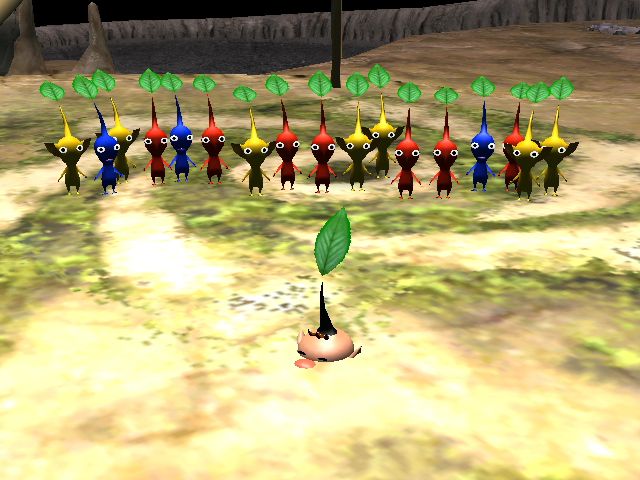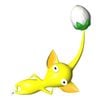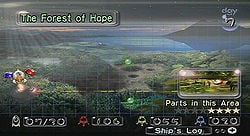Pikmin (game): Difference between revisions
m (→Releases) |
(→History: Reworked.) |
||
| Line 151: | Line 151: | ||
While experimenting with the idea for a game, Nintendo came up with a concept with the tentative title ''[[Adam and Eve]]''. It would feature two humans that would develop by themselves, but when it was deemed too uninteractive, Pikmin were added. Soon after, the whole idea was scrapped, and development for ''Pikmin'' began. The [[Red Bulborb]], which originated as a mammoth-like creature in that game, was re-used for ''Pikmin''. | While experimenting with the idea for a game, Nintendo came up with a concept with the tentative title ''[[Adam and Eve]]''. It would feature two humans that would develop by themselves, but when it was deemed too uninteractive, Pikmin were added. Soon after, the whole idea was scrapped, and development for ''Pikmin'' began. The [[Red Bulborb]], which originated as a mammoth-like creature in that game, was re-used for ''Pikmin''. | ||
The first reveal of the ''Pikmin'' project came | The first reveal of the ''Pikmin'' project came in [[Pikmin prerelease information#E3 2000 Tech Demo Show Off|E3 2000]], where [[Shigeru Miyamoto]] played the game live. By that point, the general mechanics resembled the final product, but several assets, resources and quirks were different. | ||
===Releases=== | ===Releases=== | ||
{{main|Region|Nintendo Selects}} | {{main|Region|Nintendo Selects}} | ||
The game was released on {{date|26|October|2001}} in Japan, {{date|2|December|2001}} in North America, and {{date|14|June|2002}} in Europe and Australia. In North America, | The game was released on {{date|26|October|2001}} in Japan, {{date|2|December|2001}} in North America, and {{date|14|June|2002}} in Europe and Australia. In North America, the game was originally planned to release as a GameCube launch title on {{date|11|November|2001}}{{cite web|http://www.nintendoworldreport.com/news/6494/official-pre-launch-luigis-mansion-site-online|Official Pre-Launch Luigi’s Mansion Site Online|Nintendo World Report|published|{{date|22|September|2001}}}}{{cite web|http://www.angelfire.com/oh2/gamey/NDCube.htm|Nintendo GameCube Preview (Project Dolphin)|Angelfire (user page)}}, however it was delayed for unknown reasons and was released on its {{date|2|December}} date instead. | ||
The game was officially released in different parts of the world at different times. It also had some re-releases with different packaging and usually different prices. However, there are three versions of the software, [[#Versions|listed below]]. Each physical release can have the Japanese, American, or European game disc inside. | |||
Below is a complete list of all known releases of ''Pikmin'', including the box art, release locations, and product information. | |||
{| class="wikitable sortable collapsible collapsed" | {| class="wikitable sortable collapsible collapsed" | ||
|- | |- | ||
! colspan=" | ! colspan="8" | List of physical releases | ||
|- | |- | ||
! colspan="2" | Box | ! colspan="2" | Box | ||
! rowspan="2" | Type | ! rowspan="2" | Type | ||
! rowspan="2" | | ! rowspan="2" | Location(s) | ||
! rowspan="2" | | ! rowspan="2" | Software<br>region | ||
! rowspan="2" | Release date | ! rowspan="2" | Release date | ||
! rowspan="2" | Nintendo<br>Product ID | ! rowspan="2" | Nintendo<br>Product ID | ||
| Line 172: | Line 175: | ||
! Front || Back | ! Front || Back | ||
|- | |- | ||
| [[File:Japanese Pikmin.jpg|60px]] || || Original | | [[File:Japanese Pikmin.jpg|60px]] || || Original release || Japan || Japanese || {{date|26|October|2001}} || GS-DOL-GPIJ-JPN || 4 902370 505672 | ||
|- | |- | ||
| [[File:Pikmin1boxart.jpg|60px]] || || Original | | [[File:Pikmin1boxart.jpg|60px]] || || Original release || North America || American || {{date|3|December|2001}} || DL-DOL-GPIE-USA || 0 45496 96002 5 (00100) | ||
|- | |- | ||
| [[File:PikminBoxFrontCanada.jpeg|60px]] || || Original | | [[File:PikminBoxFrontCanada.jpeg|60px]] || || Original release || Canada || American || {{date|3|December|2001}} || DL-DOL-GPIE-USA || 0 45496 96009 4 (00000) | ||
|- | |- | ||
| [[File:PikminboxfrontUK.jpeg|60px]] || || Original | | [[File:PikminboxfrontUK.jpeg|60px]] || || Original release || United Kingdom<br>Spain<br>Italy || European || {{date|14|June|2002}} || DOL-GPIP-UKV || 0 45496 96002 5 | ||
|- | |- | ||
| [[File:PikminBoxFrontAustralia.jpg|60px]] || || Original | | [[File:PikminBoxFrontAustralia.jpg|60px]] || || Original release || Australia<br>New Zealand || European || {{date|14|June|2002}} || GS-DOL-GPIP-AUS || 0 45496 96002 5 | ||
|- | |- | ||
| [[File:PikminBoxFrontGermany.jpeg|60px]] || || Original | | [[File:PikminBoxFrontGermany.jpeg|60px]] || || Original release || Germany<br>Austria<br>Switzerland || European || {{date|14|June|2002}} || DOL-GPIP-NOE || 0 45496 39015 0 | ||
|- | |- | ||
| [[File:PikminboxfrontUK.jpeg|60px]] || || Original | | [[File:PikminboxfrontUK.jpeg|60px]] || || Original release || Netherlands<br>Belgium || European || {{date|14|June|2002}} || DOL-GPIP-HOL || 0 45496 39018 1 | ||
|- | |- | ||
| [[File:PikminBoxFrontFrance.jpg|60px]] || || Original | | [[File:PikminBoxFrontFrance.jpg|60px]] || || Original release || France || European || {{date|14|June|2002}} || DOL-GPIP-FRA || 0 45496 39017 4 | ||
|- | |- | ||
| [[File:PikminBoxFrontUSAPC.jpg|60px]] || | | [[File:PikminBoxFrontUSAPC.jpg|60px]] || || Player's Choice || North America || American || {{date|9|Feburary|2003}} || DL-DOL-GPIE-USA || 0 45496 96002 5 (00101) | ||
|- | |- | ||
| [[File:PikminBoxFrontCanadaPC.jpg|60px]] || | | [[File:PikminBoxFrontCanadaPC.jpg|60px]] || || Player's Choice || Canada || American || {{date|9|Feburary|2003}} || DL-DOL-GPIE-USA || 0 45496 96009 4 (00101) | ||
|- | |- | ||
| [[File:PikminBoxFrontNetherlandsPC.jpg|60px]] || | | [[File:PikminBoxFrontNetherlandsPC.jpg|60px]] || || Player's Choice || United Kingdom<br>Spain<br>Italy || European || April 2003 || DOL-GPIP-UKV || 0 45496 39095 2 | ||
|- | |- | ||
| || || Player's Choice<br>(Silver | | || || Player's Choice<br>(Silver banner) || United Kingdom<br>Spain<br>Italy || European || April 2003 || DOL-GPIP-UKV || 0 45496 39095 2 | ||
|- | |- | ||
| [[File:PikminBoxFrontAustraliaPC.jpg|60px]] || || Player's Choice || Australia<br> New Zealand || | | [[File:PikminBoxFrontAustraliaPC.jpg|60px]] || || Player's Choice || Australia<br>New Zealand || European || April 2003 || GS-DOL-GPIP-AUS || 0 45496 96002 5 | ||
|- | |- | ||
| [[File:PikminBoxFrontGermanyPC.jpg|60px]] || || Player's Choice || Germany<br> Austria<br> Switzerland || | | [[File:PikminBoxFrontGermanyPC.jpg|60px]] || || Player's Choice || Germany<br>Austria<br>Switzerland || European || April 2003 || DOL-GPIP-NOE || 0 45496 39093 8 | ||
|- | |- | ||
| [[File:PikminBoxFrontNetherlandsPC.jpg|60px]] || || Player's Choice || Netherlands<br> Belgium || | | [[File:PikminBoxFrontNetherlandsPC.jpg|60px]] || || Player's Choice || Netherlands<br>Belgium || European || April 2003 || DOL-GPIP-HOL || 0 45496 39097 6 | ||
|- | |- | ||
| [[File:Japanese Pikmin.jpg|60px]] || || Pikmin 1 + 2 || Japan || | | [[File:Japanese Pikmin.jpg|60px]] || || Pikmin 1 + 2 || Japan || Japanese || {{date|23|July|2004}} || DOL-GPIJ-JPN || 4 902370 505672 | ||
|- | |- | ||
|} | |} | ||
''[[New Play Control! Pikmin]]'' is a different game, but a remake of this one. It was released for the [[Wii]], and features a new control method and other slight differences. | |||
===Versions=== | ===Versions=== | ||
{{main|Region | {{main|Region}} | ||
The first version of the game was released for the [[GameCube]] in Japan, in October of 2001. Throughout the next months, the game | The first version of the game, the "Japanese version", was released for the [[GameCube]] in Japan, in October of 2001. Throughout the next months, the localization team of Nintendo of America changed the game for release in North America. Finally, later, Nintendo of Europe made their own tweaks, and released that version in Europe and Oceania. Although these three regions received a different version each, the differences between them are minor. The biggest one is that the Japanese version uses Japanese text, while the others use English or European-language text. Not much changes between the US and the European versions, but it became possible to skip the [[sunset]] cutscene in the European version. | ||
Below is a complete list of all of the different versions of the game. | Below is a complete list of all of the different software versions of the game. | ||
{| class="wikitable sortable collapsible collapsed" | {| class="wikitable sortable collapsible collapsed" | ||
|- | |- | ||
! colspan=" | ! colspan="5" | List of game versions | ||
|- | |- | ||
! | ! Disc | ||
! | ! Game ID | ||
! | ! Region | ||
! | ! Region Code | ||
! | ! Publisher | ||
|- | |- | ||
| || DPIJ01 || Japan || NTSC-J || Nintendo Co., Ltd. | | || DPIJ01 || Japan || NTSC-J || Nintendo Co., Ltd. | ||
| Line 227: | Line 232: | ||
| [[File:PikminDiscEurope.jpg|60px]] || DPIP01 || Europe<br> Australia || PAL || Nintendo of Europe GmbH | | [[File:PikminDiscEurope.jpg|60px]] || DPIP01 || Europe<br> Australia || PAL || Nintendo of Europe GmbH | ||
|} | |} | ||
===Reception=== | ===Reception=== | ||
Revision as of 17:22, February 11, 2017
| Pikmin | |
|---|---|
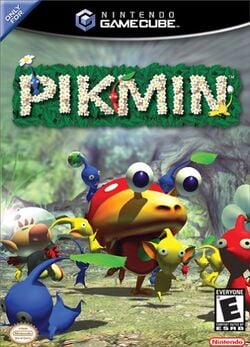
| |
| North American boxart | |
| Japanese name | ピクミン? |
| Console | Nintendo GameCube |
| Developer | Nintendo EAD |
| Publisher | Nintendo |
| Genre | Real-time strategy |
| Players | Single-player |
| Saved game size | 19 blocks |
| Release date | |
| Japan | October 26th, 2001 |
| North America | December 2nd, 2001 |
| Europe | June 14th, 2002 |
| Australia | June 14th, 2002 |
| South Korea | N/A |
Pikmin is the first game in the Pikmin series. It was released on the GameCube as a launch title, and came out on October 26th, 2001 in Japan, December 2nd, 2001 in North America, and June 14th, 2002 in Europe and Australia.
In it, Captain Olimar crash-lands on an unknown planet with indigenous creatures he calls Pikmin. They have the ability to take down obstacles, carry objects, and battle enemies. The gameplay revolves around the player controlling Olimar and managing the Pikmin so that he can recover his lost ship parts.
The game received a sequel under the title Pikmin 2, and was later remade on the Wii under the name New Play Control! Pikmin. Chronologically, this is the first game in the series.
Plot
An exhausted pilot Captain Olimar, who is seeking rest from his everyday labor as a worker for Hocotate Freight, flies his spacecraft, the S.S. Dolphin, into outer space as an interstellar vacation. Suddenly, a meteor hurdles toward his direction and hits the Dolphin, resulting in the ship plummeting toward an Earth-like planet. During the fall, the Dolphin ignites, and its parts are released from the hull and scattered across the planet.
The next morning, Olimar regains consciousness on The Impact Site and turns around to find the hull of the Dolphin badly damaged, and lacking all of its parts. He notes that the oxygen on the planet, a harmful chemical element that inhabits it, is deadly to his body, and that his life-support systems can only function for 30 days. Upon realizing this, he decides to locate the missing parts of the Dolphin, hoping he can rebuild his ship and return to his home planet of Hocotate.
After exploring a bit, Olimar finds a dormant Onion. Upon approaching it, it springs to life, and out comes a seed. Upon plucking it and experimenting with the creature by throwing it, dismissing it, etc., he learns about the Pikmin and their abilities. With the help of the Red Pikmin he raises, Olimar recovers the Main Engine, which allows him to at least hover above the surface during the night, which he later learns is too dangerous.
Olimar and the Pikmin then discover a new area, The Forest of Hope and the Onion within: the Yellow Pikmin's Onion. In addition, he gradually learns more about the various enemies and quirks of the planet, and how to use each Pikmin type's abilities to their full potential. As he gathers more parts, he eventually manages to discover The Forest Navel, the Blue Pikmin, The Distant Spring, and The Final Trial. After defeating the Emperor Bulblax and recovering the final ship part, Olimar sails back to Hocotate.
Endings
| Click [show] to display the image. |
|---|
There are three possible ways for Olimar's adventure to end, which depend on the ship parts the player can gather before the days run out. Videos of each ending can be found on the external links section of this article.
The canon ending is the best one; this is when all thirty ship parts are recovered within the thirty day time limit. After the Secret Safe is gathered, the camera zooms into the Dolphin and Captain Olimar jumps with joy. Then the scene darkens, becoming night, Olimar walks to his ship and stops to look at the Pikmin one last time. The Pikmin tilt their heads in curiosity. Olimar gives the Pikmin a short wave good-bye, to which the Pikmin tilt their heads in the opposite direction. With a sigh, Olimar looks down and shakes his head. He then boards the Dolphin and lifts off successfully, and the Pikmin attack a nearby Spotty Bulborb on their own. Next, the ship is seen flying away, with Onions of many, unseen colors following him. After the credits, the enemy reel is shown.
The average ending is when the time runs out, but Olimar manages to escape with the ship parts he collected. Out of the 30 parts, only 25 specific ones are necessary for the captain to return to Hocotate. The five optional parts are the Nova Blaster, the Space Float, the Massage Machine, the UV Lamp and the Secret Safe. With this ending, at the night of the final day, Captain Olimar walks towards the Dolphin and takes a quick glance back before entering the cockpit of his ship and attempting to blast off. He successfully flies off while three Pikmin (one red, one yellow, and one blue) look up into the sky with curiosity.
The bad ending takes place when Olimar does not manage to retrieve the 25 mandatory parts. On his last day, he realizes that time has run up and attempts to lift off. Immediately after taking off, the engine explodes and his ship crashes back onto the planet. The Pikmin carry his unconscious body to an Onion, making Olimar pop out as a Pikmin-like creature, having his normal head, but the sprout of a Pikmin with a black stem, and without his spacesuit helmet.
It is known that the best ending is the canon one, seeing as in Pikmin 2, Olimar has brought a souvenir home for his son, and the best ending is the only one where he would have time to pick one up. In addition, it's revealed that Olimar's wife eventually finds the Secret Safe during his absence, and that ship part can only be retrieved after all other 29 were. Naturally, the worst ending is not canon, as Olimar is known to return safely to Hocotate at the start of the second game.
Gameplay
Pikmin is a three-dimensional strategy-based game, in which the player is given control of Olimar, who in turn has control over the Pikmin that follow him. The whole point of the game is to find and collect as many of his lost ship parts as possible, up to the maximum of 30, in fewer than the 30 days Olimar has to live, so that he can escape the grasp of the planet before his life-support system fails. This is achieved by directing Pikmin to carry the parts to Olimar's ship. Approximately 15 minutes are spent on its surface each day; as nightfall approaches, he must gather stray and toiling Pikmin so that they don't fall victim to the voracious nocturnal predators, such as the Red Bulborb.
In Pikmin, players will face many obstacles in order to secure the parts required to rebuild the ship. This must be done with care, as many obstacles are hazardous to the Pikmin, such as water, fire and explosions. There are also other things that block the way, such as walls, bridges and gaps. Many different animal species on the planet hinder the progress of working Pikmin. However, the forces are limited; Olimar can only have up to 100 Pikmin out in the field and no more under any circumstances. The rest are stored in the Onions, considered by Olimar to be some sort of motherships for the species.
The primary way to control Pikmin is to throw them at targets, although they can also be issued to them. By gathering resources back into the Onions, new seeds will pop out, which increase the supply of Pikmin. The creatures can also mature with the likes of nectar.
Challenge Mode
- Main article: Challenge Mode in Pikmin.
In addition to the regular story mode, there is an alternate game mode where players are challenged to grow the most Pikmin they can in a single day, with slightly different rules from the norm. The best results are kept in record.
Content
Pikmin
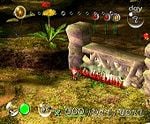
- Main article: Pikmin family.
Pikmin are the plant/animal hybrids that are discovered by Captain Olimar when he crash-landed on the planet. The Pikmin willingly follow his orders and imitate his movements, despite whatever fate may await them. Each species of Pikmin has weaknesses and strengths and all Pikmin must be used in cooperation in order to collect all of the missing ship parts. These are the types of Pikmin encountered in this game.
Red Pikmin
- Main article: Red Pikmin.
Red Pikmin are the first type of Pikmin encountered by Captain Olimar, at The Impact Site. They are used to retrieve the Main Engine, since they are the only Pikmin he has at the time. Red Pikmin are resistant to fire and are the strongest of all the Pikmin found in the game. Besides their color, they can also distinguished from other Pikmin types with their pointed nose-like growth.
Yellow Pikmin
- Main article: Yellow Pikmin.
Yellow Pikmin are the second Pikmin discovered by Olimar, found in the The Forest of Hope. Yellow Pikmin are the only Pikmin with the ability to carry bomb-rocks (in this game), and can be thrown higher than normal. The Yellow Pikmin's defining physical characteristic is their large ears.
Blue Pikmin
- Main article: Blue Pikmin.
Blue Pikmin are the third and last kind of Pikmin found in the game. They are located in The Forest Navel. Blue Pikmin are the only species of Pikmin that can move around in bodies of water, thanks to their gills. When non-blue Pikmin fall in the water, blue Pikmin will run to them and throw them out of the water, saving their lives.
Areas
The game is split into five different areas. After 1, 5, 12 and 29 ship parts are recovered, the S.S. Dolphin receives an upgrade, which allows it to fly to a different area.
- The Impact Site – the landing site. It has very few enemies and plenty of sources to grow more Pikmin with.
- The Forest of Hope – a forest.
- The Forest Navel – an underground cove.
- The Distant Spring – a piece of land mostly covered in water.
- The Final Trial – a large challenge-like level where the player's skills and knowledge are put to the test.
Ship parts
- See: Ship part
Ship parts are what the player needs to collect in order to advance with the game. There are thirty in total, and they can upgrade the S.S. Dolphin once certain amounts of parts are recovered. Each ship part is unique, and five of them are not mandatory for Olimar to succeed in his escape.
Enemies
- See: Enemies in Pikmin
There are a number of creatures in the planet that are enemies to the Pikmin. They are mostly predators, although almost all of them can be killed by large armies of Pikmin.
Plants and fungi
- See: Vegetation in Pikmin
A few decorative plants and fungi exist in each area. Most of them are plants in the real world.
Controls
- See: Controls in Pikmin
Players control the game with a GameCube controller. In-game, they take control of Olimar, and if he has any Pikmin on his group, he can control them to some degree by shifting the group's position, dismissing them, or throwing them. The player is also given some control over the camera.
Lists
Quotes
- See: Olimar's voyage log
Soundtrack
- See: Music in Pikmin
- See: Pikmin Worlds
Easter eggs and secrets
- See: Easter eggs
Regional differences
- See: Region
Mistakes
- See: Mistakes
Glitches
- See: Glitches in Pikmin
Prerelease information
Unused content
History
Development
During development of the GameCube, a tech demo was created that showed off multiple Marios, under the title Super Mario 128. This demo demonstrated the console's ability to have several dozens of individual objects on-screen at once. This concept was later recycled and lead to the creation of Pikmin.
While experimenting with the idea for a game, Nintendo came up with a concept with the tentative title Adam and Eve. It would feature two humans that would develop by themselves, but when it was deemed too uninteractive, Pikmin were added. Soon after, the whole idea was scrapped, and development for Pikmin began. The Red Bulborb, which originated as a mammoth-like creature in that game, was re-used for Pikmin.
The first reveal of the Pikmin project came in E3 2000, where Shigeru Miyamoto played the game live. By that point, the general mechanics resembled the final product, but several assets, resources and quirks were different.
Releases
- Main articles: Region and Nintendo Selects.
The game was released on October 26th, 2001 in Japan, December 2nd, 2001 in North America, and June 14th, 2002 in Europe and Australia. In North America, the game was originally planned to release as a GameCube launch title on November 11th, 2001[1][2], however it was delayed for unknown reasons and was released on its December 2nd date instead.
The game was officially released in different parts of the world at different times. It also had some re-releases with different packaging and usually different prices. However, there are three versions of the software, listed below. Each physical release can have the Japanese, American, or European game disc inside.
Below is a complete list of all known releases of Pikmin, including the box art, release locations, and product information.
New Play Control! Pikmin is a different game, but a remake of this one. It was released for the Wii, and features a new control method and other slight differences.
Versions
- Main article: Region.
The first version of the game, the "Japanese version", was released for the GameCube in Japan, in October of 2001. Throughout the next months, the localization team of Nintendo of America changed the game for release in North America. Finally, later, Nintendo of Europe made their own tweaks, and released that version in Europe and Oceania. Although these three regions received a different version each, the differences between them are minor. The biggest one is that the Japanese version uses Japanese text, while the others use English or European-language text. Not much changes between the US and the European versions, but it became possible to skip the sunset cutscene in the European version.
Below is a complete list of all of the different software versions of the game.
Reception
Pikmin received mostly positive reviews. Sites like IGN and GameSpot gave it scores close to 90%, praising its uniqueness and visuals, but complaining about the camera[source needed]. On its first week, it sold over 100,000 copies, although the numbers started decreasing in the following weeks. Ai no Uta helped boost sales, but became an unexpected hit, even surpassing the sales for the game itself.
Credits
- See: Pikmin credits
Gallery
- See also: Promotional material in Pikmin.
- Olimarpromotional.jpg
A promotional picture, advertising Pikmin.
Player's Choice box art.
- A few mpikmin leaf.jpg
Concept art.
Trivia
- Page 23 of the instruction manual describes a strategy against Red Bulborbs, but contains a typo: it has "holdung on to the feet" instead of "holding on to the feet".
- During the game's development, it was originally planned to be a different game, called Adam and Eve, featuring elements from a canceled Mario game, Super Mario 128. This idea was canceled because Miyamoto couldn't think of a storyline.
- Some of the resources used for the scenery in the game come from the mountains and the gardens around Shigeru Miyamoto's house.[3]
- It is possible to collect all 30 ship parts in 6 in-game days. Such a playthrough is known as a 6-day run.
See also
External links
- Wikipedia's article on Pikmin
- StrategyWiki's article on Pikmin
- NintendoWiki's article on Pikmin
- Pikmin game manual
- YouTube video of the good ending
- YouTube video of the neutral ending
- YouTube video of the bad ending
References
- ^ Official Pre-Launch Luigi’s Mansion Site Online on Nintendo World Report
- ^ Nintendo GameCube Preview (Project Dolphin) on Angelfire (user page)
- ^ YouTube video where Miyamoto explains the resource's origins (at 11:11)
| Games | |
|---|---|
| Main games | Pikmin • Pikmin 2 • Pikmin 3 • Pikmin 4 |
| Spin-off games | Hey! Pikmin • Pikmin Bloom |
| Re-releases | New Play Control! Pikmin • New Play Control! Pikmin 2 Pikmin 3 Deluxe • Pikmin 1 (Nintendo Switch) • Pikmin 2 (Nintendo Switch) |
| Web games | Pikmin.com SpaceForce • Pikmin Treasure Hunt • Pikmin Finder |
| Super Smash Bros. series | Brawl • for Nintendo 3DS and Wii U • Ultimate |
| Others | Pikmin Adventure (Nintendo Land) • Stage Debut |
